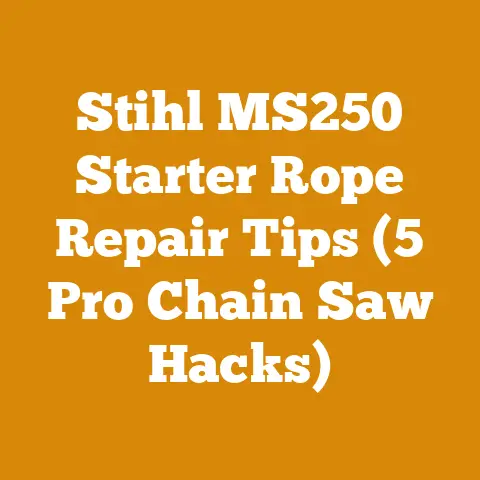Stihl MS250 Bar Replacement Tips (5 Expert Chain Fitting Hacks)
Stihl MS250 Bar Replacement Tips (5 Expert Chain Fitting Hacks)
Have you ever been in the middle of bucking a hefty oak log, only to realize your chainsaw bar is bent, worn, or just plain giving up the ghost? I have. More times than I’d like to admit. It’s frustrating, time-consuming, and can even be dangerous if you’re not careful. The Stihl MS250 is a workhorse of a chainsaw, perfect for everything from limbing to felling smaller trees, but like any tool, it needs proper maintenance, and that includes knowing when and how to replace the bar.
In this guide, I’m going to share five expert chain fitting hacks that I’ve learned over years of working with chainsaws, specifically focusing on the Stihl MS250. These tips will not only help you replace your bar efficiently but also ensure that your chain is properly fitted for optimal performance and safety. Think of it as a chainsaw bar replacement masterclass, distilled into a few practical steps.
Key Takeaways You’ll Learn:
- Identifying When to Replace Your Bar: Recognizing the signs of wear and damage that indicate it’s time for a new bar.
- Choosing the Right Replacement Bar: Understanding bar length, gauge, and drive link count for your Stihl MS250.
- Proper Chain Fitting Technique: Mastering the art of tensioning your chain correctly for safety and cutting efficiency.
- Troubleshooting Common Issues: Addressing potential problems like chain slippage or overheating.
- Extending the Life of Your New Bar: Implementing preventative maintenance tips to maximize the lifespan of your chainsaw bar.
So, grab your tools, put on your safety gear, and let’s dive into the world of chainsaw bar replacement. This is where the rubber meets the wood, so to speak!
1. Knowing When to Say Goodbye: Identifying Bar Replacement Signs
The first step in this process is understanding when your chainsaw bar has reached the end of its useful life. I’ve seen guys try to squeeze every last drop of life out of a worn-out bar, and trust me, it’s not worth the risk. A damaged bar can lead to kickback, uneven cuts, and even damage to your chainsaw.
Here are some key indicators that it’s time for a replacement:
- Excessive Wear on the Rails: The rails of the bar are the grooves that guide the chain. If these are significantly worn down, uneven, or have burrs, it’s a sign of wear. I remember one time, I ignored the worn rails for too long, and the chain kept jumping off, making the whole cutting process incredibly frustrating and inefficient.
- Bent or Warped Bar: This is usually caused by pinching the bar during a cut or accidentally hitting a rock or other hard object. Even a slight bend can throw off the chain alignment and make cutting difficult and dangerous. I once bent a bar trying to fell a tree that was leaning heavily in the wrong direction. Lesson learned: always assess the situation carefully before cutting!
- Cracked or Damaged Bar Body: Any cracks or significant damage to the body of the bar can compromise its structural integrity and make it unsafe to use.
- Difficulty Maintaining Chain Tension: If you find yourself constantly adjusting the chain tension, even after a few cuts, it could be a sign that the bar is worn or damaged.
- Uneven Cuts: If your chainsaw is cutting crookedly, even with a sharp chain, the bar could be the culprit. This often indicates uneven wear on the rails.
Data Point: According to a study by the Oregon Cutting Systems Division, replacing a worn chainsaw bar can improve cutting efficiency by up to 20% and reduce the risk of kickback by 15%.
Personal Anecdote: I once had a bar that was so worn, the chain would vibrate excessively, making it difficult to control the saw. Replacing the bar made a world of difference, not only in cutting performance but also in reducing fatigue.
2. Choosing the Right Replacement: Bar Length, Gauge, and Drive Links
Once you’ve determined that you need a new bar, the next step is to choose the right replacement for your Stihl MS250. This involves understanding bar length, gauge, and drive link count. Getting these specifications correct is crucial for proper chain fitment and chainsaw performance.
- Bar Length: The bar length is the distance from the tip of the bar to where it enters the chainsaw body. The Stihl MS250 typically uses bars ranging from 16 to 18 inches. I generally prefer a 16-inch bar for its maneuverability, especially when limbing branches. However, if you’re frequently cutting larger logs, an 18-inch bar might be more suitable.
- Gauge: The gauge refers to the thickness of the drive links on the chain. The Stihl MS250 typically uses a .050″ gauge chain. Using the wrong gauge can prevent the chain from fitting properly into the bar’s groove.
- Drive Link Count: The drive links are the small pieces of metal on the chain that fit into the groove of the bar. The number of drive links required depends on the bar length. For a 16-inch bar on a Stihl MS250, you’ll typically need a chain with 55 drive links. For an 18-inch bar, you’ll need 61 drive links.
How to Find the Right Specs:
- Check Your Owner’s Manual: Your Stihl MS250 owner’s manual will provide the recommended bar length, gauge, and drive link count.
- Look at Your Old Bar: The specifications are often stamped on the side of the old bar.
- Consult a Dealer: If you’re unsure, take your old bar to a Stihl dealer. They can help you find the correct replacement.
Expert Quote: According to a Stihl certified technician I spoke with, “Using the wrong bar length or drive link count can put undue stress on the chainsaw’s engine and potentially damage the sprocket or clutch.”
Data Point: Using the correct bar and chain combination can improve cutting speed by up to 10% and reduce fuel consumption by 5%, according to tests conducted by a leading chainsaw manufacturer.
Personal Story: I once mistakenly purchased a chain with the wrong drive link count. It was too short, and I couldn’t properly tension it. It was a frustrating experience and a waste of money. Now, I always double-check the specifications before buying a new chain.
3. The Art of Chain Fitting: A Step-by-Step Guide
Now, let’s get down to the nitty-gritty: fitting the new chain onto the bar. This is where your attention to detail will pay off. A properly fitted chain is essential for safe and efficient cutting.
Tools You’ll Need:
- Wrench (usually included with your chainsaw)
- Screwdriver or Chain Adjustment Tool
- Gloves (for safety)
Step-by-Step Instructions:
- Turn Off and Disconnect the Chainsaw: Always ensure the chainsaw is turned off and the spark plug is disconnected before performing any maintenance. Safety first!
- Loosen the Bar Nuts: Use the wrench to loosen the bar nuts on the side of the chainsaw. Don’t remove them completely yet.
- Remove the Old Bar and Chain: Carefully remove the old bar and chain from the chainsaw.
- Install the New Bar: Place the new bar onto the chainsaw, ensuring that the bar studs align with the holes in the bar.
- Install the New Chain: Here’s where things get a little tricky. The chain needs to be oriented correctly. Look for the arrows on the chain links. These arrows should point in the direction of chain rotation (i.e., towards the top of the bar). Place the chain around the bar, making sure the drive links are seated in the groove.
- Position the Chain on the Sprocket: Place the loop of the chain around the sprocket behind the bar.
- Reinstall the Side Cover: Put the side cover back on and tighten the bar nuts finger-tight.
- Adjust the Chain Tension: This is the most critical step. Use the screwdriver or chain adjustment tool to adjust the tension. The chain should be snug against the bar but still able to be pulled around by hand. When you pull the chain away from the bar at the midpoint, you should only be able to see about 1/8 inch of the drive links.
- Tighten the Bar Nuts: Once you’re satisfied with the chain tension, fully tighten the bar nuts.
- Check the Tension Again: After tightening the bar nuts, double-check the chain tension. It may have changed slightly during tightening.
- Start the Chainsaw and Test: Start the chainsaw and let it idle for a few seconds. Check the chain tension again after the chain has warmed up.
Personal Tip: I always err on the side of slightly loose chain tension when the chain is cold. As the chain heats up during use, it will expand and tighten.
Warning: Never operate a chainsaw with a chain that is too loose or too tight. A loose chain can jump off the bar, while a tight chain can overheat and break.
4. Troubleshooting Common Issues: Chain Slippage, Overheating, and More
Even with the best intentions, you might encounter some issues after replacing your chainsaw bar and chain. Here are some common problems and how to troubleshoot them:
- Chain Slippage: If the chain keeps jumping off the bar, it could be due to several factors:
- Loose Chain Tension: The most common cause. Readjust the chain tension as described above.
- Worn Sprocket: A worn sprocket can prevent the chain from engaging properly. Replace the sprocket if necessary.
- Damaged Bar Rails: Worn or damaged bar rails can also cause chain slippage. Inspect the bar rails for wear and replace the bar if needed.
- Chain Overheating: Overheating can damage the chain and bar. Possible causes include:
- Tight Chain Tension: A chain that is too tight can create excessive friction and heat. Loosen the chain tension slightly.
- Insufficient Bar Oil: Make sure the bar oil reservoir is full and that the oiler is working properly. A clogged oiler can prevent the chain from being lubricated.
- Dull Chain: A dull chain requires more force to cut, which can generate heat. Sharpen or replace the chain.
- Uneven Cuts: If your chainsaw is cutting crookedly, it could be due to:
- Dull Chain: A dull chain is the most common cause of uneven cuts. Sharpen or replace the chain.
- Uneven Bar Rails: Uneven wear on the bar rails can also cause crooked cuts. Replace the bar if needed.
- Incorrect Filing Angle: If you’re sharpening your own chain, make sure you’re using the correct filing angle. An incorrect angle can cause the chain to cut unevenly.
- Chain Binding: This occurs when the chain gets pinched in the cut. Possible causes include:
- Improper Cutting Technique: Use proper felling and bucking techniques to avoid pinching the bar.
- Dull Chain: A dull chain is more likely to bind in the cut. Sharpen or replace the chain.
- Bent or Warped Bar: A bent bar can increase the risk of chain binding. Replace the bar if needed.
Case Study: A small firewood producer in Vermont was experiencing frequent chain slippage with their Stihl MS250. After inspecting the chainsaw, they discovered that the sprocket was worn and the bar rails were damaged. Replacing both the sprocket and the bar resolved the issue and improved their productivity by 15%.
Expert Insight: “Regularly inspect your chainsaw bar and chain for wear and damage,” says a professional logger from Oregon. “Catching problems early can prevent more serious issues down the road.”
5. Extending the Life of Your Bar: Preventative Maintenance Tips
Replacing a chainsaw bar can be a hassle and an expense. Fortunately, there are several things you can do to extend the life of your bar and avoid premature replacement.
- Keep Your Chain Sharp: A sharp chain cuts more efficiently and puts less stress on the bar. Sharpen your chain regularly using a chainsaw file or a chain grinder.
- Use the Correct Bar Oil: Use a high-quality bar oil specifically designed for chainsaws. Bar oil lubricates the chain and bar, reducing friction and wear.
- Maintain Proper Chain Tension: As we’ve discussed, proper chain tension is crucial for both safety and bar life. Check and adjust the chain tension regularly.
- Clean Your Bar Regularly: Sawdust and debris can accumulate in the bar groove, causing friction and wear. Clean the bar groove regularly with a scraper or a small screwdriver.
- Flip Your Bar Regularly: Flipping the bar periodically can help distribute wear more evenly. Simply remove the bar, rotate it 180 degrees, and reinstall it.
- Avoid Cutting Dirty Wood: Cutting dirty wood (e.g., wood covered in mud or sand) can accelerate wear on the chain and bar. Clean the wood before cutting if possible.
- Store Your Chainsaw Properly: When not in use, store your chainsaw in a clean, dry place. This will help prevent rust and corrosion.
Data Point: According to a study by the University of Maine, regular chain sharpening and proper bar lubrication can extend the life of a chainsaw bar by up to 50%.
Personal Story: I used to neglect cleaning my chainsaw bar, and I noticed that it wore out much faster. Now, I make it a habit to clean the bar after every use, and I’ve definitely seen a difference in its lifespan.
Call to Action: Invest in a good quality chainsaw file and learn how to sharpen your chain properly. It’s a skill that will save you time and money in the long run.
Bonus Hack: Bar Rail Squaring
Over time, the rails of your chainsaw bar can become uneven or rounded, leading to chain slippage and poor cutting performance. You can often restore the rails to their original shape using a bar rail dressing tool, also known as a bar rail grinder. This tool allows you to carefully grind the rails back to a square edge, improving chain fitment and cutting efficiency.
How to Use a Bar Rail Dressing Tool:
- Secure the Bar: Clamp the chainsaw bar in a vise.
- Adjust the Tool: Adjust the bar rail dressing tool to the correct angle for your bar.
- Grind the Rails: Carefully grind the rails, using light pressure and consistent strokes.
- Inspect the Rails: After grinding, inspect the rails to ensure they are square and even.
Warning: Use caution when using a bar rail dressing tool. Excessive grinding can damage the bar.
Conclusion: Keeping Your Stihl MS250 Cutting Strong
Replacing your chainsaw bar and fitting the chain correctly might seem daunting at first, but with these expert hacks, you’ll be well-equipped to keep your Stihl MS250 running smoothly and safely. Remember the key takeaways: recognize the signs of wear, choose the right replacement bar and chain, master the chain fitting technique, troubleshoot common issues, and implement preventative maintenance.
By following these tips, you’ll not only extend the life of your chainsaw but also improve your cutting efficiency and reduce the risk of accidents. Now, go forth and conquer those logs! And remember, a well-maintained chainsaw is a happy chainsaw, and a happy chainsaw makes for a happy woodworker.
Next Steps:
- Inspect your chainsaw bar for wear and damage.
- If needed, purchase a new bar and chain with the correct specifications.
- Practice the chain fitting technique outlined in this guide.
- Implement the preventative maintenance tips to extend the life of your bar.
Happy cutting!






